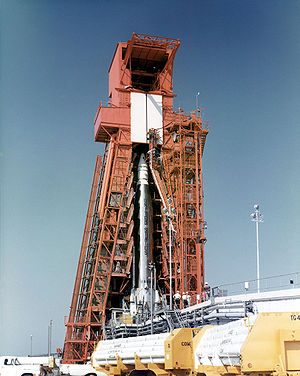- Cape Canaveral Air Force Station Launch Complex 12
-
Launch Complex 12 
Atlas D with FIRE 1 at LC-12Launch site Cape Canaveral Air Force Station Location 28°28′49″N 80°32′31″W / 28.480314°N 80.542058°W Short name LC-12 Operator US Air Force Total launches 38 Launch pad(s) One Launch history Status Dismantled First launch Atlas A 10A
10 January 1958Last launch Atlas-Agena D 5103
5 November 1967Associated rockets Atlas A
Atlas C
Atlas D
Atlas-Able
Atlas-AgenaLaunch Complex 12 (LC-12) at Cape Canaveral Air Force Station, Florida is a launch pad used by Atlas rockets and missiles between 1958 and 1967. It is the second-most southern of the pads known as missile row, between LC-11 to the south and LC-13 to the north. Along with Complexes 11, 13 and 14, featured a more robust design than many contemporary pads, due to the greater power of the Atlas compared to other rockets of the time. It was larger, and featured a 6 metres (20 ft) tall concrete launch pedestal and a reinforced blockhouse. The rockets were delivered to the launch pad by means of a ramp on the southwest side of the launch pedestal.
Atlas A, C and D missiles were tested from the site. It was also used for orbital launches of Atlas-Able and later Atlas-Agena rockets, and two Project FIRE suborbital tests for Project Apollo, using Atlas D rockets.
On 24 September 1959, the first Atlas-Able, 9C, exploded during a static firing test at LC-12, after a turbopump on one of the engines failed triggering a complete engine shutdown. The damaged turbopump continued to allow oxidizer to flow, feeding the fire beneath the vehicle. About a minute later the rocket suffered a structural failure, collapsed and exploded. Damage from the explosion took seven months to repair, with the next launch from the complex occurring in May 1960.
In 1961, LC-12 was converted to support the Atlas-Agena rocket. The first Atlas-Agena launch from LC-12 was in August 1961. On 23 April 1962, Atlas-Agena B 133D launched Ranger 4, the first American spacecraft to reach the surface of the Moon, when it made a hard landing at an impact speed of 9,617 kilometres per hour (5,976 mph).
On 27 August 1962, Mariner 2 was launched by Atlas-Agena B 179D, the first spacecraft conduct a successful flyby of another planet when it flew past Venus on 14 December 1962. On 28 July 1964, Atlas-Agena B 250D launched Ranger 7, which was the first fully successful Ranger mission. On 28 November 1964, Atlas-Agena D 288D launched with Mariner 4, which provided the first close-up pictures of Mars.
In 1967, LC-12 became the third of the four Atlas pads to be deactivated. Following deactivation, the launch tower, mobile service structure and launch support equipment were dismantled, and the site is no longer maintained.
References
Coordinates: 28°28′49″N 80°32′31″W / 28.480314°N 80.542058°W
Cape Canaveral and Merritt Island launch sites Atlantic Missile Range drop zone • Grand Turk Island drop zone • Mobile Launch Area • SLBM Launch Area • Patrick AFB • Shuttle Landing Facility • Cape Canaveral AFS Skid StripCategories:- Buildings and structures in Brevard County, Florida
- Cape Canaveral Air Force Station
Wikimedia Foundation. 2010.
